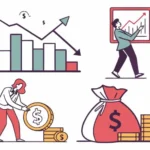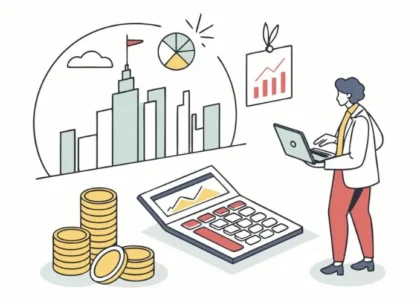Dear Investor / Partner
In this quarterly letter we cover the following:
- Seasons in Investing and how they compare to seasons in farming.
- Investing in the US vs Investing in India: Which one is compelling and why?
- Corporate tax cut in India and how it impacts the valuation of companies.
- A case study from a sector that we like.
Through these quarterly letters we talk about topical things and relate them to the age old wisdom of investing. So let us get started.
Seasons in Investing
Investing is aptly compared to farming. As in farming, there are times when a particular activity will lead to better outcome in investing. Let us push this analogy further and look at it in terms of seasons in farming and how they correlate with seasons in investing.
Sowing season
This is the time when farmer should sow the seed. Mother Nature will give adequate sunshine, rain and appropriate temperature. In other words, conditions will be right for the crop to grow. All the farmer needs to do is to put the right seed, provide the right nutrients to the crop along the way and take good care of the crop.
In a similar way, there are times when sowing (buying) your investment is likely to provide better results. These are the times to deploy your hard earned money (seeds) into a fertile land. Just like in farming, there is a risk in investing that some of the seeds (investments) won’t amount to anything.
Read moreHarvesting season
The crop has blossomed and all the time and effort put in the field is reflected in the bounty in the field. This is the time when farmer cuts the crop and bags the harvest. This enables him to have seeds for the next sowing season.
In a similar way, an investment blossoms over time. Depending on the investment (seed) and the thesis, these investments will take a few quarters to a few decades. When the thesis has run its course, it is time to harvest and prepare for the next opportunity (sowing season).
Where did the analogy break?
The farming analogy fits investing nicely. However, we should be aware of the following aspects where it diverges:
- Unlike in farming, in investing, the length of the season is not pre-ordained. In farming if you sow a wheat seed you know it will take 4 months; if you sow a sugarcane seed it will take 18-24 months. However, in investing the actual length of a season may turn out to be very different from expectation.
- Like in farming, there is a risk that you sowed the wrong investment. However, unlike in farming, in investing one can recover a portion of our wrong seed (investment) and put it to more productive use.
- In farming, the yield from the seed is within a given range. In investing the yield from an investment can be unlimited. One only has to look at Berkshire Hathaway and many of the other successful companies to understand the difference between what you sow and what you reap.
- In farming, a farmer doesn’t project the recent past into the future. So if a crop gives him a good yield he doesn’t assume that the yields will continue to grow. However, investors often get caught up in hysteria and panic. This leads to bubbles and manic drops in the stock market.
While we can come up with a few more differences in the above analogy, you get the drift. In investing as in farming we need to be approximately right rather than to be perfect. Keeping this in mind let us move to the next section.
Investing in the US vs Investing in India
I am spending quite a bit of my time in the US these days. I am often asked why I focus on investing in India when US markets are doing so well. Having spent time in the US gives me a great vantage point to compare the investing mindset in the US with the investing mindset in India keeping the farming analogy in mind.
US Investors
Investors in US have been lulled into complacency. It is like a mango tree that has given bountiful mangoes for the last 10 years. The farmer now expects that this outcome is a given for the foreseeable future. 10 years of bull market in US have made the investors de-prioritize the risks that are lurking around the corner:
- Passive investing has become all the rage since the market has only gone one way – upwards. This has driven the valuation of large caps to unrealistic levels. Recently, I heard that Exxon Mobile is in at least 100 ETFs ranging in style from value to growth, from US-focused to International, and from cyclical to secular.
- Investors are thinking that they are diversifying when they buy different ETFs. However, most of the large ETFs have the same set of stocks!
- Investors are ebullient as the Fed is cutting rates. However, trade wars, immigration policies, and high budget deficits are likely to be inflationary which will tie the Fed’s hands.
- Trillions of dollars are fetching negative yields (in Europe and Japan) which are encouraging investments to go into unproductive assets.
- New companies are being valued at an unrealistic valuation (Beyond Meat is valued at $8.6BN while revenue in Q4 2018 is $67MM with a loss of $9MM!).
Currently investors are focusing on “return on their money.” At some point in the not too distant future the focus will shift to “return of their money.” At that point, investors will once again be reminded that “investors often get caught up in hysteria and panics.” Hence, it seems more like a harvesting season for many of the big companies in US.
Indian Investors
In the last quarter I talked about how investing in India is about investing in 2 market caps:
- Large caps: These continue to do well.
- Mid and small caps: These have been decimated and many people have started throwing in the towel.
While we don’t know when the market sentiment will turn in mid and small caps, we do think that mid and small caps provide interesting opportunity at current valuation. Thus it seems to us that it is sowing season for mid and small caps while harvesting season in the large caps.
One particular sector that we like in the current mayhem is the NBFC sector. NBFCs have been hurt badly in the last 1 year as the liquidity has become extremely tight. Markets are currently projecting that this situation will continue. We think that the situation is likely to revert in the next 1-2 years. Besides, NBFCs have demonstrated good agility and will be able to adapt their business model to reflect the changing ground reality.
Of course, any talk about investing in India cannot be complete without the recent corporate tax cut that was enacted.
Corporate tax cut
The Indian government recently reduced the corporate tax rate from 35% (including various surcharges and cess) to 25% effective financial year 2020. This is a very good supply-side measure and should put India on the map for companies that are looking to relocate their manufacturing factories from other locations. It will also be a big fillip to Indian corporates which have been paying the full tax rate of 35%. Their after-tax earnings go up by 15% in FY 20 (due to the tax reduction) without any underlying change in business economics.
Financial companies will be a significant beneficiary as they pay the full tax rate. We think that while most private banks trade at expensive valuations, selective NBFCs don’t reflect the incremental value that has been given back to shareholders from the government.
Case Study
We recently wrote a case study on one of the NBFC stocks. This case study is available on our website at the following link. If you end up reading it, do let us know your feedback.
Parting thoughts
We like communicating through these quarterly letters. It helps us keep you abreast of our thinking given market events. In addition, it forces us to write more and learn more. We agree with the teaching method followed by doctors, “see one, do one, teach one.”
show less










